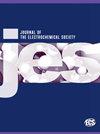VO2-C Materials Prepared from Citric Acid Organic Skeleton as C Matrix as Anode for Aqueous Zinc Ion Batteries
IF 3.1
4区 工程技术
Q2 ELECTROCHEMISTRY
引用次数: 0
Abstract
Designing and synthesizing aqueous zinc ion battery cathode materials with high specific capacity and stability remains a significant challenge. In this study, citric acid was selected as the reducing agent for converting V2O5 to VO2 within a carbon matrix using the hydrothermal method. Citric acid acts as a nucleocrystal, forming nanoparticles through self-assembly from within, creating a distinct micromorphological structure in V4+ materials. It exhibits excellent electrochemical performance as a cathode material for aqueous zinc ion batteries, showing a high specific capacity of 399.33 mAh g-1 at 1A g-1, and a capacity retention of up to 98.3% after cycling for 1000 cycles at a high current density of 5A g-1.以柠檬酸有机骨架为 C 基质制备的 VO2-C 材料可用作锌离子水电池的阳极
设计和合成具有高比容量和稳定性的水性锌离子电池阴极材料仍然是一项重大挑战。本研究选择柠檬酸作为还原剂,利用水热法在碳基质中将 V2O5 转化为 VO2。柠檬酸可作为核晶,通过内部自组装形成纳米颗粒,在 V4+ 材料中形成独特的微晶结构。作为锌离子水电池的阴极材料,它表现出优异的电化学性能,在 1A g-1 的条件下,比容量高达 399.33 mAh g-1,在 5A g-1 的高电流密度下循环 1000 次后,容量保持率高达 98.3%。
本文章由计算机程序翻译,如有差异,请以英文原文为准。
求助全文
约1分钟内获得全文
求助全文
来源期刊
CiteScore
7.20
自引率
12.80%
发文量
1369
审稿时长
1.5 months
期刊介绍:
The Journal of The Electrochemical Society (JES) is the leader in the field of solid-state and electrochemical science and technology. This peer-reviewed journal publishes an average of 450 pages of 70 articles each month. Articles are posted online, with a monthly paper edition following electronic publication. The ECS membership benefits package includes access to the electronic edition of this journal.

 求助内容:
求助内容: 应助结果提醒方式:
应助结果提醒方式:


